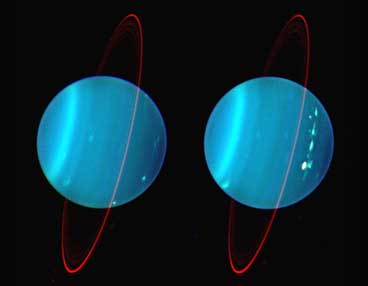
Technical caption:
This figure provides examples of recent Uranus imaging with the Keck NIRC2 near-infrared camera on 11-12 July 2004 UT. These two images show opposite sides of the planet, with Uranus' north pole at 4 o'clock. Each color image is a composite in which near infrared images using J (1.26 micron), H (1.62 micron), and K' (2.1 micron) filters are assigned to blue, green, and red color components respectively. This roughly approximates the view that would be available to human vision if the response of the eye could be shifted to longer wavelengths beyond red (0.7 microns). Uranus' rings appear red in color because the K' image is boosted relative to the others to reveal atmospheric features that are strongly darkened by methane absorption in this band. The use of near IR wavelengths provides exceptional cloud contrast, which is enormously enhanced by the Keck AO system. The diameter of Uranus in these images is about 3.6 arc seconds, and the effective image resolution is probably near 0.06 arc seconds. When examined carefully, the left image reveals 13 cloud features and the right image displays over 18, for a total of 31 features in just two images. The bright white feature in the right hand image has exceptional brightness in the K' band, meaning it extends to relatively high altitude, and it strongly variable, as is the unusually large complex of clouds associated with it, both having changed dramatically by our next observing run in August 2004. The isolated relatively bright green cloud near the lower left limb in the right hand image is the very long-lived feature that oscillates in latitude. The northern hemisphere of Uranus (on the right) is coming out of a long period of darkness and is not a mirror image of the southern hemisphere, indicating that there is some response to seasonal solar radiative forcing, even though little response was expected. The zonal wind speeds are asymmetric as well as the cloud morphology.
Photo credit: courtesy Lawrence Sromovsky, UW-Madison Space Science and Engineering Center.
High-resolution 200 DPI JPEG